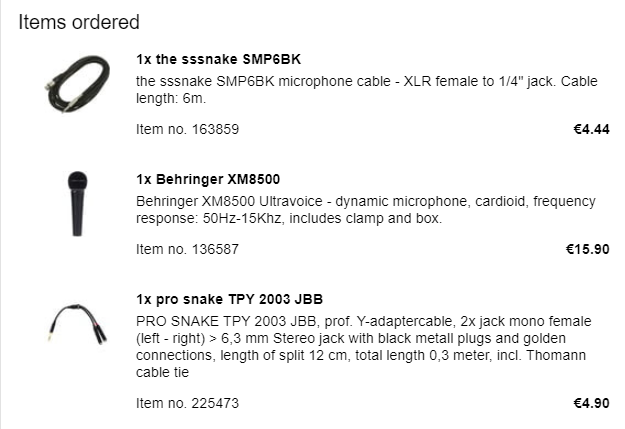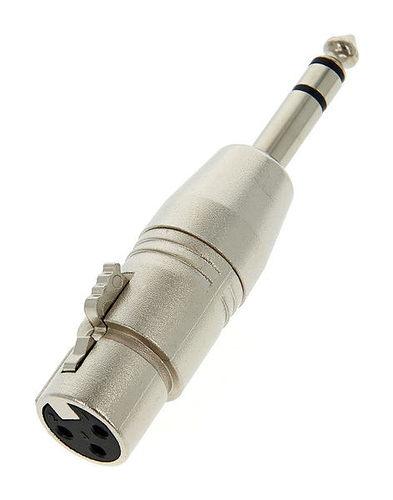I plan to use my axolotis inputs using the two inserts on my mackie 802vlz. Channel 1 should be for vocals and maybe channel 2 ill hook up a little diy piezo drum pad. That should allow for a little cleaner preamping of the signal before it his the axo's DSP.
Connecting a microphone
I inserted a microphone yesterday and while at first I only needed to boost 20dB and +6dB to see the input go up half the vu-meter, at some point it just suddenly dropped and became very silent.. (using an superlux WH5 microphone.. good looking, but very cheap)
So I'm a bit of afraid to boost even more as I thought I might have been overloading the input somehow?
Luckily I have two more boards and one of the three boards is going to be a midi-sequencer anyways, but it might be good to know whether I'm save on this, before I try it with the others....
Are you using an XLR-to-unbalanced jack cable?
Does the input still work with a line level source?
Sounds like the specifications changed between the different versions of the board (1.0, 1.1, 1.2). I read "electrets need bias voltage... needs circuit modification" (August 2015), but I also have in the library the "audio/inconfig mic" object, designed for electret. Is it now (v 1.2) ready to use an electret?
That would be great to include a detailed input description/explanation of the different options in the Hardware User Guide section (or is it already there, or somewhere else?)
Thanks!
There are no changes between different board revisions (1.0, 1.1, 1.2) that affect electret microphone connectivity.
To enable bias voltage for electret microphones, R17 and R18 need to be populated with 2kOhm resistors (value suggested in the ADAU1361 datasheet), and enabled with the "audio/inconfig mic" object. Use size "0603" resistors.
But populating R17 and R18 will reduce the input impedance significantly and (but still not quite sure about this) add crosstalk (between left and right input channels), even when electret bias is disabled with the "audio/inconfig mic" object. So that's why R17 and R18 are not populated in production.
related topic
Great, good to know. I don't plan on making the modification. It would be great (necessary?) to add a note in the "audio/inconfig mic" object mentioning that this object works only with a hardware modification (but I'm a newbie here, still learning how the software documentation works).
Thanks!
hey I got this cheap little mic but I am unsure if it's possible to connect to the axoloti:
The comments say it's dynamic mic, it hast a stereo 3,5mm jack.
When I plug it straight into the axo it's no sound. I also tried to put the sleeve to ground, no input either. Any Ideas?
"However a dynamic microphone - Sure SM58 and similar - can be connected. It is important that you use an XLR to mono jack cable."
I thought I once read that you couldn't connect a mono-plug to the stereo input, did I misread that?
Because of this I added a small passive mixer and a stereo-to-2mono Y-splitter cable between the axoloti and the mic (and a XLR-to-mono-jack between mic and mixer) , but this current setup is just VERY noisy... Could you please verify for me how to connect a SM58 microphone? As the first time I did this a couple of years ago, I burned a board... don't want to ruin my newest board too..
Good question!
I was also thinking that using a mono jack into a stereo input would give problems as then the mono shield would be connected to a left or right of the stereo input, right?
So I was also thinking of using a stereo male jack to two mono female jacks. This makes it also possible to connect two microphones.
So I am actually looking for such a cable but that is hard to find, so maybe I need to make it myself.
Any thoughts on this?
Hi,
I am following this thread for a while. I am looking for a safe way to connect 2 sure E835 dynamic mics to the 2 inputs.
I was planning to do this with following cables:
that connect to
for the output:
Reading this thread I have become a little bit scared on blindly testing things.
@johannes: does it need to be balanced or unbalanced?
Would this setup be ok?
thanks for any advise!
ps. My Axoloti adventure is taking me on a sleepless but magnificant trip... what a platform!
oh, I didn't follow up on this, but I had some insight of friends. Seems that by connecting two microphones, they start to influence each other and they need to be pre-amplified (/buffered) before being connected to the input.
So, perhaps it's a good thing to come up with a small circuit that can pre-amplify the microphones with an amp-IC fed by the axoloti, both with normal microphone inputs as well as inputs for piezo elements.
I've been using the pro snake TPY 2003 JBB cable with two contact microphones and it works fine. Haven't tested with dynamic mics.
I got the microphone and the cables. Everything works really nice, so good solution to use a stereo to two mono female jack for the inputs.
I am now trying to make a sampler. It already starts to work but needs more work.
For example, if I record in a table 32b sdram and use start and stop, and do this a second time with shorter recording. Then when playing the table, it first play the newly recorded sample. and then it plays what still is in the table.
So I probably need to record the position also somewhere, but don't know how to do this yet..
But already having lots of fun with this!
the issue here is that with the shorter new sample you only overwrite the first part of your sample table. you need to flush the table before recording so it's empty. i don't think there's a readdy made object for this yet, but very easy to make yourself. just set all table array values to 0.
fwiw i intentionally left this very same misbheaviour in my poly synth, because it causes some really fun interesting randomness, especially becausee all my sample are in the same pitch. so then i get random gglitch samples on long sustained notes.
oh one more thougght, alternatively you can store the sample length on record somewhere andd then condition the playback so it stops after SAMPLELENGTH. but that seems more effort than just nulling the table.
Yeah, I have to admit that it can lead to some creative effects, already had some yesterday 
But I'm also curious how to have more control. So how to get the samplelength or position.
So setting all table value, would you do this using a for loop? or is there a clear method?
yeah i couldnt see a clear method. loop through the whole thing and set to 0. or maybe, i don't really know c, you can set the whole array to 0 with table[]=0;? either way, a quick flushing loop shouldnt last longer than one k-rate cycle.
there should be a couple length options. quick look at privatepublic (thx @cpwitz!!!) gave m thisrbrt/data/f2s
edit. maybe this works?memset(arr, 0, sizeof arr);
Hi all. For the sake of simplicity, wouldn't it be possible and safe to simply use one of these for connecting a dynamic mic???


